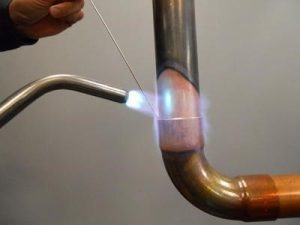When it comes to brazing, there are two main equipment choices: setups utilizing oxygen/acetylene or those using air/acetylene torches
Traditionally, oxygen/acetylene rigs have dominated many HVAC brazing applications across the United States. However, air/acetylene torches represent a viable alternative option. Contractors who have experimented with air/acetylene often value their enhanced portability and reduced operating costs, advantages that can outweigh the slight tradeoff of longer heating times.
Operating Principles
The primary distinction between the two torch types lies in how the acetylene fuel gas undergoes combustion.
Figure 1 depicts an elbow joint being brazed using an air/acetylene torch to melt the brazing alloy.
Oxygen/Acetylene and Air/Acetylene Combustion
An oxygen/acetylene system requires two separate cylinders – one containing compressed acetylene gas and another with compressed high-purity oxygen. These two gases are metered and mixed to produce an intense, high-temperature flame.
In contrast, an air/acetylene setup utilizes just a single acetylene cylinder and draws the oxidizer (oxygen) from the surrounding atmospheric air. This reliance on air, which contains only around 21% oxygen, has historically made achieving brazing temperatures challenging for conventional air/acetylene torch designs. Consequently, these torches were better suited for lower-temperature soldering applications.
Modern Design Innovations
Recent advancements like swirl combustion technology have enabled air/acetylene systems to become viable for high-heat brazing processes. In these advanced torches, the expanding acetylene gas flow through the tip creates a Venturi effect that draws in increased air volumes. The accelerated mixing of air and acetylene, combined with a swirling vane that homogenizes the gases, produces a more oxygen-rich combustible mixture burning at higher efficiency. This unique tip design gives the flame its characteristic swirling pattern.
Safety Considerations
Because an oxygen/acetylene system involves premixing two separate gases, there is an inherent risk of a flashback occurring where the premixed gases ignite within the equipment. This safety hazard is reduced with air/acetylene torches since only the single acetylene gas is employed. Visit aws.org/standards/page/safety-health-fact-sheets to learn more about welding safety practices.
Comparing the Setups
For common HVAC oxygen/acetylene rigs, the cylinder sizes are typically the industry-standard MC (10 ft3) for acetylene and R (20 ft3) for oxygen. While compact and portable, these differing cylinder volumes result in an uneven consumption rate between the two gases. As a result, contractors may need to transport backup cylinders or make frequent cylinder swap-outs to avoid disrupting their workflow.
To attain the desired neutral flame condition for oxygen/acetylene brazing, the oxygen-to-acetylene ratio should be maintained close to 1.1:1. Achieving this precise gas mixture ratio is critical for optimal combustion temperature and efficiency. However, this necessitates careful monitoring of gas consumption rates, as improper adjustments can lead to wasted gas and an inefficient flame.
Air/acetylene setups simplify gas supply logistics by only requiring a single MC or B-size acetylene cylinder. This eliminates juggling multiple cylinders and potential supply hassles. Furthermore, since the oxygen is drawn from air, these torches provide greater flexibility in adjusting gas ratios to finely tune the flame characteristics for the specific brazing requirements.
Flame Characteristics and Brazing
Oxygen/acetylene flames typically reach temperatures around 5400°F at the inner cone tip, while air/acetylene flames measure roughly 3000°F at a similar location, though temperatures can vary.
For processes like welding or cutting, the intense concentrated heat of the oxygen/acetylene flame is necessary. However, brazing relies on a different joining mechanism called capillary action to draw molten filler metal into the joint area. To enable uniform capillary action, both workpieces require even preheating before adding the brazing rod. This broad preheating promotes heat conduction throughout the joint and raises both components to the required brazing temperature.
When oxygen/acetylene is used for brazing, continuous torch motion is needed to evenly distribute heat since the highest temperatures are focused at the inner cone tip. The torch also needs to be held farther away to prevent overheating and potential burn-through, especially on sensitive materials like brass or aluminum. The broader air/acetylene flame, however, allows positioning the inner cone closer to the workpiece for extended periods without burn-through risk. The flame’s wider heat distribution envelops tubing and fittings more uniformly, providing more consistent preheating which makes brazing easier, particularly for less experienced technicians according to many industry experts.
The Final Analysis
While oxygen/acetylene systems offer versatility across various applications, air/acetylene torches are frequently the preferred choice specifically for soldering tasks and can provide certain advantages like enhanced usability and cost-effectiveness for particular brazing operations.
source: www.aws.org

